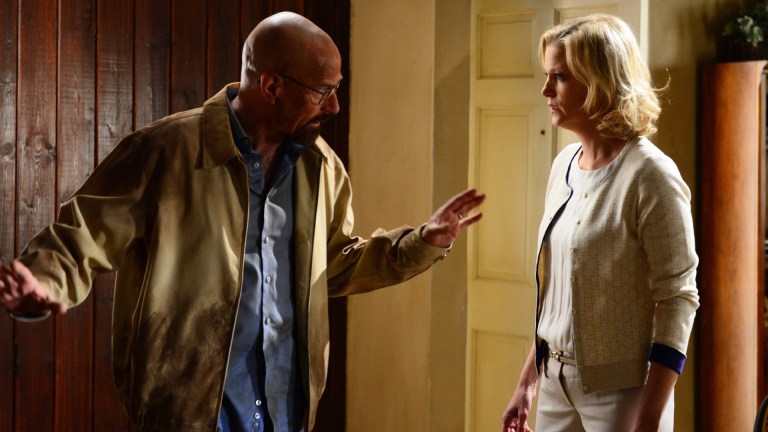TV Has Yet to Top the Horror of Breaking Bad’s “Ozymandias”
Breaking Bad's "Ozymandias" is rightfully regarded as of one the best TV episodes of all time. One scene in particular makes clear why.

This article contains spoilers for Breaking Bad season 5 episode 14 “Ozymandias.”
Breaking Bad’s final season is 10 years old. It’s hard to believe it’s been a decade since Walter White’s story came to a close. All of the deceit, violence, plot twists, and puzzling cliffhangers the series provided still occupy a mountain of space in our heads, just begging for yet another rewatch. In the time since the final episodes of the beloved crime drama aired, no show has quite matched the exquisite pacing and pitch-perfect tone of the eight episodes that concluded Walter’s time as the meth kingpin of New Mexico. Still, even amongst an array of masterpiece hours of television in the second half of the show’s fifth and final season, the Rian Johnson-directed epic “Ozymandias” stands tall above all else.
“Ozymandias” starts with a nearly 15-minute scene in which Hank (Dean Norris) is killed by Uncle Jack (Michael Bowen) and his gang of Nazis, Jesse (Aaron Paul) is essentially sold into meth manufacturing slavery to Todd Alquist (Jesse Plemons), and Walt wanders through the desert in search of transportation back home. The sheer amount of action during this time period would be enough for most shows already, but Breaking Bad was just getting started.
The scene when Walter arrives home to Walter Jr. (R.J. Mitte) and Skyler (Anna Gunn), apoplectic and deliriously wondering why they won’t believe him about Hank’s death, is where the episode truly enters the pantheon of TV greatness and even ascends to a higher legend regardless of medium. Skyler has decided that she simply won’t stand for Walt’s intimidation tactics and disregard for the White family any longer, and this is when “Ozymandias” turns into one of the most bone-chilling horror flicks of the 21st century.
Fans of Vince Gilligan’s show will instantly recognize the cadence of the scene from the jump. Walter goes into persuasive essay mode when Skyler makes the heavy claim that Walt killed Hank. Walt always has one more lie in the chamber, one more plea for survival when his time is up. This time his elaborate, emotional explanations are raw and real, but why would Skyler know that? She’s had to play along with Walt’s games for five seasons now, and this time there is no turning back.
The camera closes in on the set of knives in the kitchen. Even as Walter paces back to the bedroom to pack his family’s belongings, Walter Jr. on his tail fishing for answers, Skyler stalks the weapons that are just mere meters away from her hands. The matriarch of the White family goes on the offensive, building a symbolic and literal barrier between herself, her son, and the criminal father whose immoral acts have multiplied for 60 episodes up to this point.
When Walt approaches Skyler with a lack of sincerity, she swings at her husband with the blade, slicing into the flesh of his hand. The look of unadulterated shock on Walt’s face is where the scene turns into a Kubrickian chill ride. Not a single note of music or background sound assaults the senses as Walter and Skyler commence years of frustration pent up inside of them, fighting for the handle of the killing object with their entire might. Cranston and Gunn are beyond bombastic in these 30 seconds of madness, culminating in Walter Jr. careening into the violence when he realizes his mother is overpowered.
For so much of the series, Walter Jr. views his father as an idol, a man he can admire for inspiration. On a dime, he’s able to flip his perception of his parents, saving the guardian who actually deserved his respect this whole time. This character development choice combines with Johnson’s decision to pan the camera slowly out from the family, coalescing into a frightening epiphany for Walter and the viewers at home: the nerdy science teacher from the pilot episode has transformed into an antagonist worthy of our shame.
“We’re a family.” As Walter bellows these heartbreaking words, the cries of baby Holly and Skyler paint the picture of what type of household Walter has decimated. A wife, son, and infant daughter are the victims of a mass murderer, a drug dealer, and a psychopath. Especially when juxtaposed with the cold open of the episode, when Walter and Skyler are planning mundane scheduling occurrences such as what to eat for dinner and vital, life-changing moments like what to name their unborn child, this horror scene defines the fall from grace that Gilligan so desperately set out to craft.
Walter Jr. calls the police on his father, and in a split second, Walter digs into his authentic self, kidnapping his daughter to gain leverage over Skyler one last time. When Skyler realizes what’s happened, she dashes outside and pounds on the window panes of the dilapidated truck Walter escapes in. The most menacing part of the exchange is Walt’s decision to forcibly back his way out of the driveway, ignoring the family SUV behind him. The red vehicle ends up halfway down the street, the sounds of screeching metal echoing in unison with the haunting score now being played in the background.
The weight of these sounds crescendos with Skyler’s begging for Walt to cede control of the baby. Anna Gunn’s performance here makes the entire scene, and it’s as beautifully acted as any clip in the show. She won multiple Emmy Awards for Best Supporting Actress for the fifth season, but infinite adulation seems more apt. Gunn forces the audience to sympathize with her, even after some questionable decisions in the third and fourth seasons of the series.
These four minutes pack more story into their allotment than most shows do in an hour. We learn so much about all three characters, their motives, and where they are headed at the show’s cataclysm. The roller coaster Rian Johnson builds feels like a Rube Goldberg machine of horror. Every action causes a chain reaction that expounds upon the previous one. There’s no time for the audience to take a single breath, and we often have to make split-second emotional decisions about the characters we’ve all come to love at one point or another. Johnson has the gall to jostle with that profound connection and shatter the anti-hero trope that Walter White came to define. Cranston’s character is Jack Torrance, and we’re all whimpering Wendy.
“Ozymandias” is still the textbook example of television horror for the last 10 years and will be for at least another 10.
Breaking Bad is available to stream on Netflix in the U.S. and U.K.
